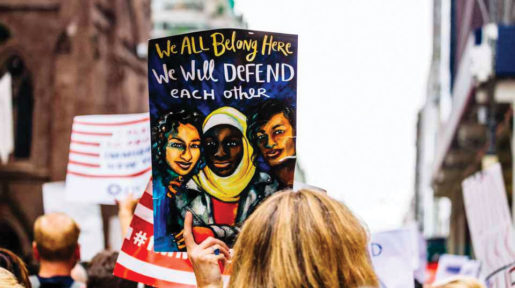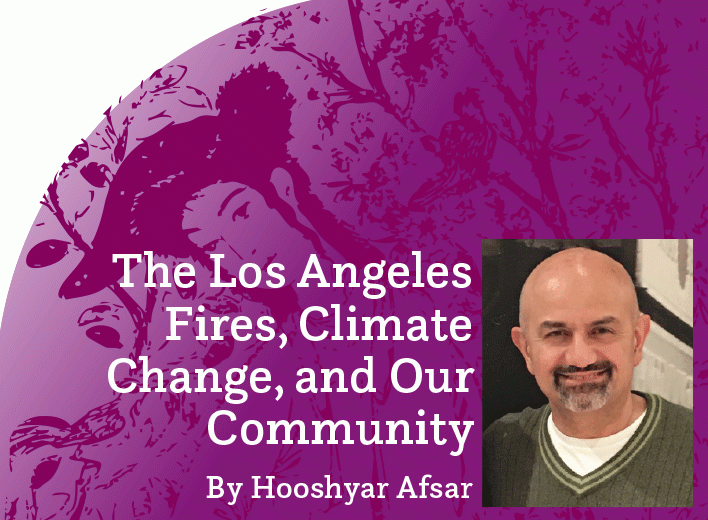by Hooshyar Afsar

Throughout U.S. history, immigrant rights and open immigration policies have been closely tied to the adoption of or opposition to white supremacy and racism. In other words, major developments towards racial justice have facilitated more open immigration policies in the direction of a multi-racial democracy. On the other hand, the racist trends in the opposite direction have curtailed openness in immigration and the rights of immigrants living in this country. These trends have not only been confined to limiting “non-white” new immigrants into the country, they have also brought forth discriminatory policies against immigrants already in the country, including legal and naturalized ones. In fact, the notion of naturalization has always been tied to immigration regardless of whether immigrants were given a path to citizenship. That’s why it is key to start by looking at the history of citizenship.
Citizenship and the U.S. Constitution
Naturalization and citizenship are key aspects of immigrant rights in the U.S.; the rights of an American citizen have been at the heart of the struggle for racial justice since the founding of the nation. The original constitution made naturalization legislation part of the powers of the Congress (legislative branch) in section 8 of Article I by briefly stating “Congress shall have power … To establish a uniform rule of naturalization.” Accordingly, the notion of who could become a U.S. citizen was first addressed in the Naturalization Acts of 1790, 1795, 1798, and 1802.
Citizenship in the 1790s: “Whites Only”
Per the original constitution, the first Congress passed the Naturalization Act of 1790 limiting the naturalization eligibility to “free white person[s]…of good character.” The first four naturalization acts did not shun this openly white supremacist notion. It is important to note that immigrants from various ethnicities came into the country during this time, while enslaved African people were kidnapped and shipped to this country under horrible conditions. Yet even free blacks and all other “non-whites’’ could not become U.S. citizens. This meant that all immigrants who were not considered “free white person[s]…of good character” could not become citizens either and enjoy the rights that came with citizenship.
Rights of Citizens Prior to the Civil War and Reconstruction: Federal v. State
The original constitution referred to the word citizen ten times but it did not define citizenship. Article IV, Section 2 is known as the “Comity Clause,” which states: “The Citizens of each State shall be entitled to all Privileges and Immunities of Citizens in the several States.” Historian Eric Foner, in his recent book The Second Founding, writes that this language “seems to suggest that the rights of citizens are determined by states rather than Federal government” (page 4). But what did the Bill of Rights have to say about the topic? After all, the first ten amendments ratified in 1792 by all the states guaranteed a whole set of individual rights, starting with freedom of speech. Again Foner argues that prior to the Civil War, the “Bill of Rights” was really intended to protect individual citizens from the federal government; t was only after the Civil War–and during the 12-year period known as Reconstruction–that the “Bill of Rights” was used to argue against the states (specifically Southern states) violating the rights of citizens (page 74).
Immigrant Rights During the “Second Founding”
The three Reconstruction-era amendments–namely, the 13th, 14th, and 15th amendments–were so groundbreaking in shifting the U.S. Constitution toward the rights of citizens and equality that the era was treated as a second founding of the nation. The “Second Founding” term was first used at the time by the Republican Senator Carl Schurz; it’s an interesting irony that Schurz was a progressive who fought in the 1848 German revolution and emigrated to the U.S. in 1852 and later fought as a general in the Union Army during the Civil War.
A simplistic view of the Second Founding amendments is that 13th amendment made slavery illegal, the 14th ammendment declared enslaved people citizens, and the 15th amendment gave former enslaved people the right to vote. That view is technically correct, yet it is a limited view on the scope of these amendments and their impact on citizenship and immigrant rights. The 13th amendment not only made slavery illegal, it also banned “involuntary servitude,” directly impacting millions of future immigrants who could be brought into this country as indentured servants. The 14th amendment not only granted citizenship to formerly enslaved people, it brought forth the idea of birthright citizenship and equal protection of the laws, including the right to life, liberty, and property and due process for “any person.” This meant that these rights applied to all immigrants living in the United States–not just the citizens. Finally, the 15th amendment provided the right to vote for all citizens regardless of their race, color, or previous condition of servitude (but not regardless of their sex, as women would not gain the right to vote until 1920). Again, this meant that all (male) citizens regardless of their background had the right to vote. Of course, as many historians and scholars agree, the full implementation of these three amendments is still a work in progress today as we shall see below, yet they took the constitution of the United States to a new level and created a bedrock for the probable eventuality of arriving at a multi-racial and mulit-ethnic democracy.
Jim Crow, Segregation, and Immigrants
Unfortunately, racism and white supremacy as the most terrible legacys of slavery continued to live on when Reconstruction ended abruptly in 1877 with the withdrawal of Union troops from the South. This gave rise to the emergence of a whole new system of racial and social control known as “Jim Crow laws” or segregation. While this new system took roughly a couple of decades to fully emerge, as inscribed in the constitutions and laws of the Southern states, its seeds had been already planted right after the defeat of the pro-enslavement confederacy in 1865 with the introduction of “Black Codes” in the South. Even though segregationist laws and constitutions were predominantly used in the South, over 40 states (yes, 40) had segregationist laws, many of them impacting immigrants. In fact, the state of California–that today may seem to be at the frontline of progressive politics–enacted 17 segregationist laws between 1866 and 1947, including six miscegenation laws which prohibited the reproduction by people who were believed to be members of different races. At the federal level, one clearly racist example was the Chinese Exclusion Act of 1882 that banned the immigration of Chinese laborers. This shameful act was built on the Page Act of 1875, which mixed racism and misogyny, prohibiting the immigration of Chinese women to the United States. It is clear that “Jim Crow” segregation violating the human rights of African Americans went hand in hand with racist and discriminatory laws against legal immigrants living in the U.S. and those immigrating to this country.
These policies continued during the Hoover administration, which exploited Great Depression joblessness as an anti-immigrant ploy claiming that “foreigners” stole American jobs. An August 2018 article in The Washington Post reported that up to a million American citizens of Mexican descent were deported under this policy. This is yet another clear example that while Jim Crow segregation ravaged the South and over 40 states had such laws, discrimination and even deportation was used against legal immigrants and even American citizens. Jim Crow segregation continued during the administration of FDR, whose New Deal policies for the most part left African Americans out and largely benefited the white working class. FDR refused to support a federal anti-lynching law while this instrument of terror continued to be used in the South and other states. He even resisted his own better half, Elenaor Roosevelt, who called for such legislation. Is there any surprise that FDR’s government then rounded up over 110,000 Japanese Americans, including second and third generations, and sent them to concentration camps after Japan attacked Pearl Harbor? There are stories of pregnant second-generation Japanese Americans living under awful conditions in the camps while their husbands were fighting for the U.S. armed forces against Japan.
The 1960s Civil Rights Movement and its Effect on Immigration
Until 1965, immigration in the United States was based on a “national origins formula” starting with the 1921 Emergency Quota Act that was openly racist and intended to maintain the ethnic makeup of the country as white Protestant of European descent. In fact, the 1924 Immigration Act included an Asian Exclusion Act that barred not only Chinese immigrants, but all Asians from immigrating to the United States. The law was pro-Northwest Europe and had provisions against Italians, Asians, and Eastern Europeans, including Jews from that region. The 1952 Immigration and Nationality Act that was passed during the dark days of McCarthyism changed the Asian Exclusion Act, yet only gave a quota of 100 immigrants per year to each Asian country. It was used to bar many progressive writers or activists from entering the United States.
Then came the full force of the Civil Rights Movement, culminating in the passage of the 1964 Civil Rights Act and the 1965 Voting Rights Act. The hard-fought struggle of Black people along with all progressives of different ethnicities brought about these key victories. It was no accident that less than two months after the passage of the historic Voting Rights Act, the historic Immigration and Nationality Act–also known as the Hart-Cellar Act–ushered in a new era of immigration towards a mutli-racial and multi-ethnic democracy. The act removed the “national origins formula” and its Northwest European focus and ended discrimination against Asians, Africans, and all other non-Northwestern European ethnicities. It also gave priority to relatives of U.S. Citizens and green card holders, professionals, and refugees.
Our Iranian American community never would have reached its current size and influence if it were not for the passage of the 1965 Immigration Act. We and other immigrant communities directly benefited from the accomplishments of the Civil Rights Movement.
Iranian Americans and the Future of U.S. Immigration
The last four years of the Trump administration did significant damage to immigrant communities in general–and the Iranian American community in particular–by way of the ”Muslim Ban” and other openly discriminatory policies. Our community has been deprived of new blood and our children have been dispossessed of contact with their family members in Iran, an essential aspect of retaining and transferring our cultural heritage to the next generations of Iranian Americans.
History was repeated on November 3, 2020, when the activism of Black people, especially that of Black women, helped elect Joe Biden and Kamala Harris, the first woman vice president who is also the first vice president of African and Asian descent. With a stroke of the pen on his first day in office, President Biden ended the Muslim Ban. This was the result of the progressive movement’s victory in the United States; a new president, who has declared ending systemic racism as part of his agenda, ended an openly discriminatory and anti-immigrant policy among many others. As over 240 years of American history has shown, the future rights of the Iranian American community and all immigrant communities shall be closely aligned with the future of the racial justice movement in this country. Our choice in this matter shall make a difference.

















